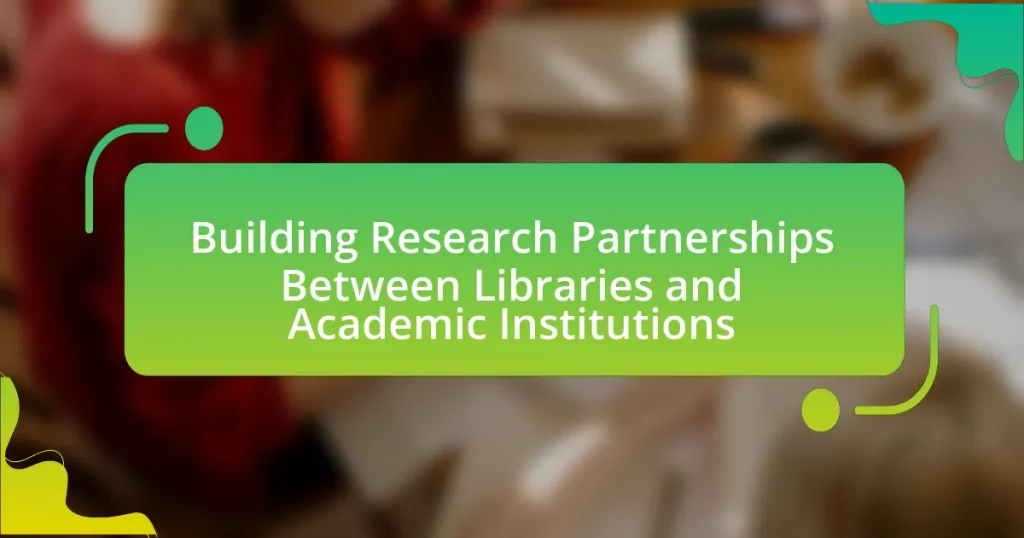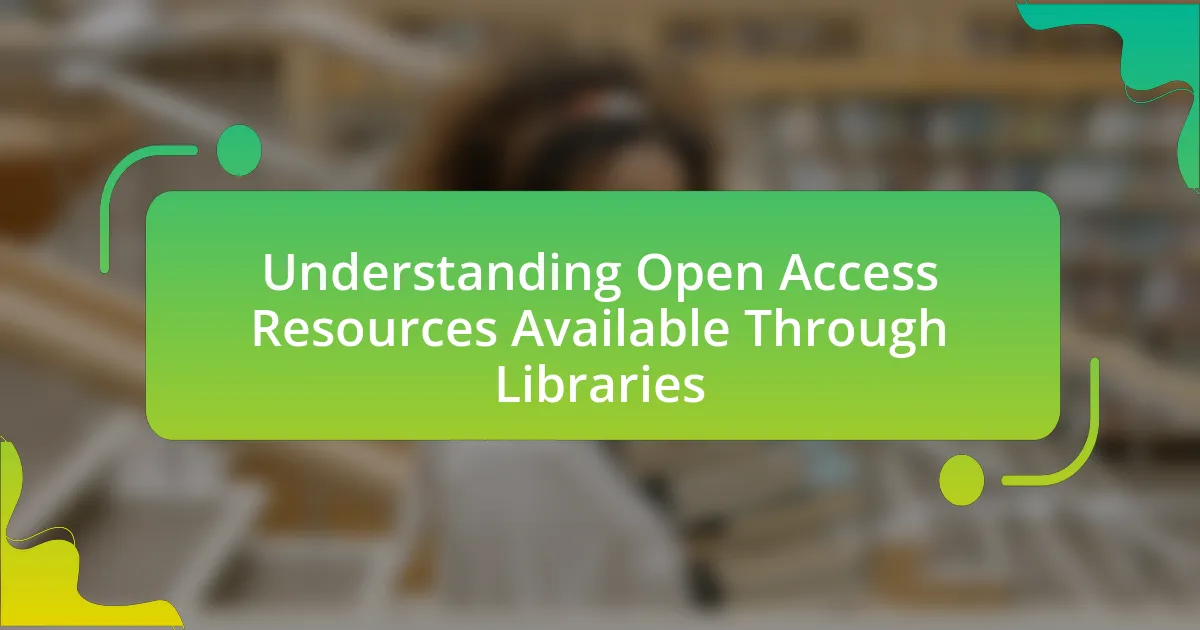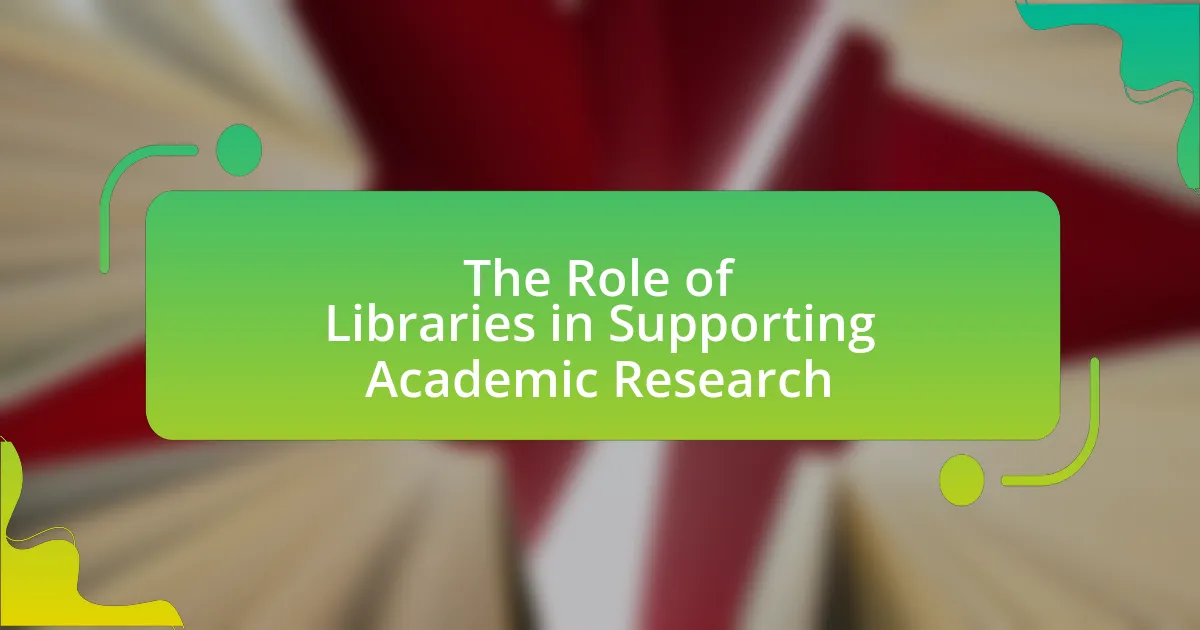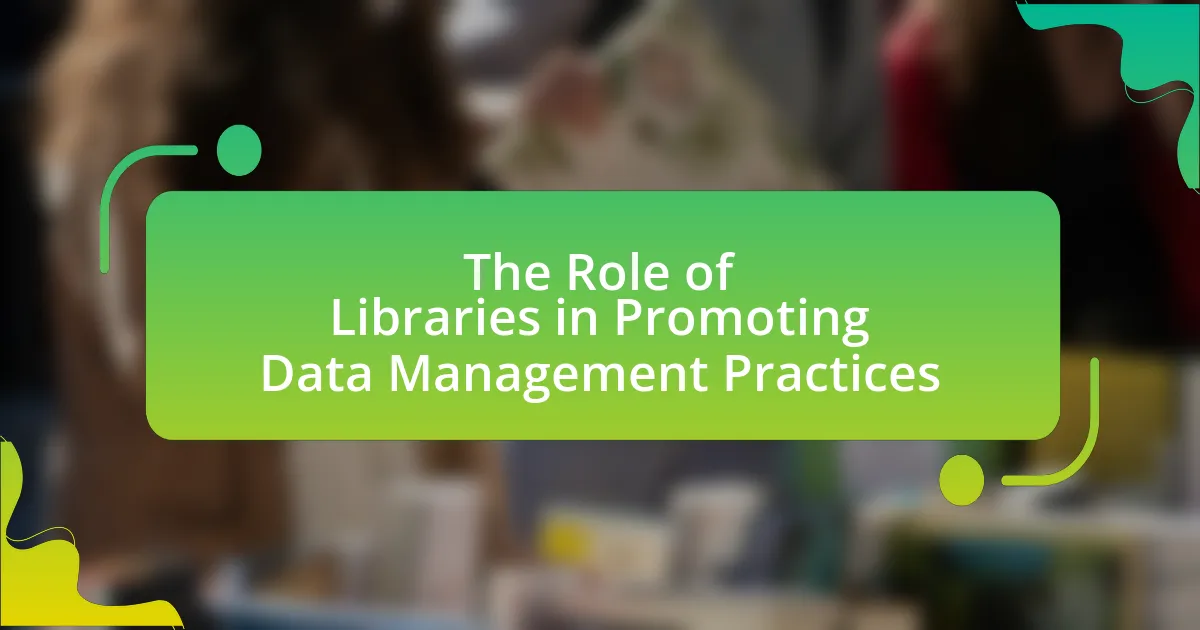Research partnerships between libraries and academic institutions are collaborative efforts designed to enhance research capabilities and resource sharing. These partnerships involve libraries providing access to information resources and research support, while academic institutions contribute expertise and funding. The article explores how these partnerships form, the roles libraries play, the benefits for academic institutions, and their importance in the academic landscape. It also discusses the challenges faced in building these collaborations, strategies for effective communication, and best practices for ensuring sustainability and success in research partnerships. Additionally, it highlights metrics for evaluating partnership outcomes and presents case studies that illustrate successful collaborations.
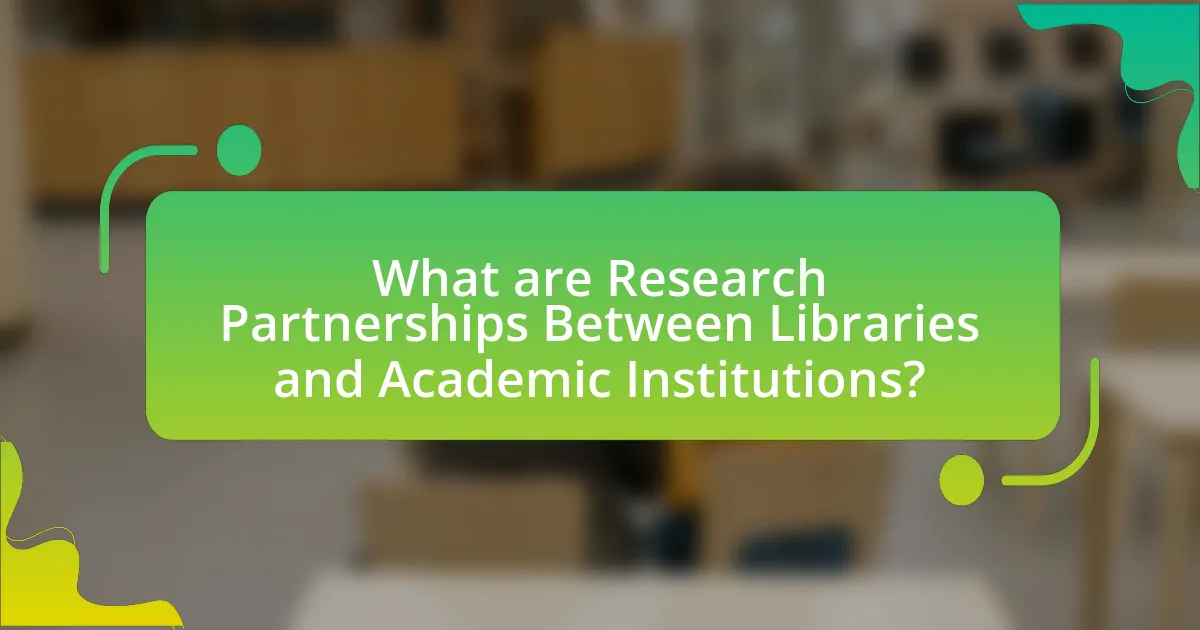
What are Research Partnerships Between Libraries and Academic Institutions?
Research partnerships between libraries and academic institutions are collaborative efforts aimed at enhancing research capabilities and resources. These partnerships typically involve libraries providing access to information resources, data management support, and research assistance, while academic institutions contribute expertise, research projects, and funding. Such collaborations can lead to improved research outcomes, increased visibility of scholarly work, and the development of innovative services tailored to the needs of researchers. For instance, a study by the Association of College and Research Libraries highlights that partnerships can facilitate shared access to digital resources and foster interdisciplinary research initiatives, demonstrating their effectiveness in advancing academic research.
How do these partnerships typically form?
Partnerships between libraries and academic institutions typically form through collaborative initiatives aimed at enhancing research capabilities and resource sharing. These collaborations often begin with mutual recognition of shared goals, such as improving access to information or supporting academic programs. For instance, libraries may reach out to academic departments to identify specific research needs, leading to joint projects or funding applications. Evidence of successful partnerships can be seen in programs like the Association of College and Research Libraries’ (ACRL) Framework for Information Literacy, which encourages libraries to engage with faculty to integrate information literacy into curricula, thereby fostering collaborative relationships.
What roles do libraries play in academic research partnerships?
Libraries play a crucial role in academic research partnerships by providing access to resources, facilitating collaboration, and offering expertise in information management. They serve as repositories of scholarly materials, including journals, databases, and archives, which are essential for researchers. Additionally, libraries support interdisciplinary collaboration by connecting researchers across different fields and institutions, enhancing the scope and impact of research projects. Furthermore, librarians contribute their expertise in data management, information literacy, and research methodologies, ensuring that researchers can effectively navigate and utilize information resources. This multifaceted involvement of libraries in academic research partnerships is evidenced by studies showing that institutions with strong library support report higher research productivity and collaboration rates.
How do academic institutions benefit from collaborating with libraries?
Academic institutions benefit from collaborating with libraries by gaining access to extensive resources, expertise, and support for research and learning. Libraries provide academic institutions with a wealth of information, including access to databases, journals, and archives that enhance the quality of research. Additionally, librarians offer specialized skills in information literacy, helping students and faculty navigate complex information landscapes effectively. This collaboration fosters an environment conducive to innovation and academic success, as evidenced by studies showing that institutions with strong library partnerships report higher research output and improved student performance.
Why are these partnerships important in the academic landscape?
Partnerships between libraries and academic institutions are crucial in the academic landscape because they enhance resource sharing and collaborative research efforts. These collaborations enable libraries to provide access to a wider range of academic resources, including databases and archives, which supports faculty and student research. For instance, a study by the Association of College and Research Libraries found that institutions with strong library partnerships reported improved research outcomes and increased publication rates among faculty. This evidence underscores the importance of such partnerships in fostering an enriched academic environment.
What impact do they have on research quality and accessibility?
Research partnerships between libraries and academic institutions significantly enhance research quality and accessibility. These collaborations facilitate resource sharing, improve access to diverse information sources, and promote interdisciplinary research, which collectively leads to higher-quality outputs. For instance, a study published in the Journal of Academic Librarianship found that libraries that actively engage in partnerships with academic departments report improved research outcomes due to enhanced access to specialized resources and expertise. Furthermore, these partnerships often result in the development of open-access initiatives, which increase the visibility and dissemination of research findings, making them more accessible to a broader audience.
How do they enhance the educational experience for students and faculty?
Research partnerships between libraries and academic institutions enhance the educational experience for students and faculty by providing access to a wealth of resources and expertise. These collaborations facilitate the sharing of information, enabling students to engage with diverse materials and perspectives that enrich their learning. For instance, libraries often offer specialized databases, archives, and research support that are crucial for academic success. Additionally, faculty benefit from these partnerships through collaborative research opportunities, access to funding, and enhanced visibility for their work. Studies have shown that institutions with strong library partnerships report higher levels of student engagement and improved academic outcomes, demonstrating the significant impact of these collaborations on the educational landscape.
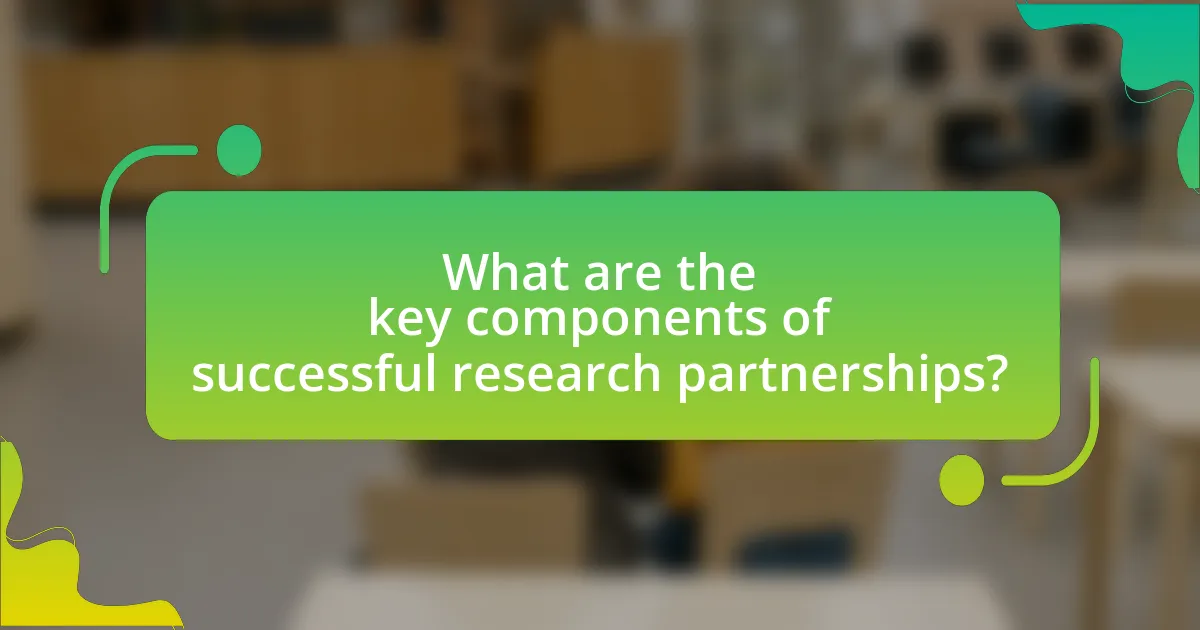
What are the key components of successful research partnerships?
The key components of successful research partnerships include clear communication, mutual goals, trust, and resource sharing. Clear communication ensures that all parties understand their roles and expectations, facilitating collaboration. Mutual goals align the interests of the partners, driving the research forward effectively. Trust fosters a positive working relationship, encouraging open dialogue and problem-solving. Resource sharing, including access to data, funding, and expertise, enhances the capabilities of each partner, leading to more impactful research outcomes. These components are supported by studies indicating that effective partnerships often result in higher quality research outputs and increased innovation.
What strategies can libraries and academic institutions use to collaborate effectively?
Libraries and academic institutions can collaborate effectively by establishing joint research initiatives that leverage shared resources and expertise. This strategy allows both entities to pool their knowledge and capabilities, enhancing the quality and scope of research projects. For instance, the Association of College and Research Libraries (ACRL) emphasizes the importance of partnerships in advancing academic research, highlighting successful collaborations that have led to innovative outcomes. Additionally, creating inter-institutional committees can facilitate ongoing communication and alignment of goals, ensuring that both libraries and academic institutions remain focused on mutual objectives. Such structured collaboration has been shown to increase research output and improve access to information resources, as evidenced by studies indicating that collaborative research efforts often yield higher citation rates and broader dissemination of findings.
How can communication be improved between libraries and academic institutions?
Communication between libraries and academic institutions can be improved through regular collaborative meetings and the establishment of formal communication channels. Collaborative meetings allow both parties to discuss needs, resources, and strategies, fostering a shared understanding of goals. Establishing formal communication channels, such as dedicated email lists or online platforms, ensures timely information sharing and enhances transparency. Research indicates that effective communication strategies lead to better resource utilization and improved academic outcomes, as seen in studies highlighting the positive impact of library partnerships on student success and faculty research productivity.
What tools and technologies facilitate these partnerships?
Collaboration platforms and communication tools facilitate partnerships between libraries and academic institutions. Tools such as Slack, Microsoft Teams, and Zoom enable real-time communication and project management, fostering collaboration among researchers and librarians. Additionally, shared document platforms like Google Drive and Dropbox allow for easy access to resources and data sharing, enhancing the efficiency of joint research efforts. Project management software, such as Trello or Asana, helps in organizing tasks and timelines, ensuring that all parties remain aligned on project goals. These technologies have been shown to improve collaboration effectiveness, as evidenced by studies indicating that teams using collaborative tools report higher satisfaction and productivity levels.
What challenges do libraries and academic institutions face in building partnerships?
Libraries and academic institutions face several challenges in building partnerships, primarily including differing institutional priorities, resource constraints, and communication barriers. Differing institutional priorities can lead to misaligned goals, where libraries may focus on information access while academic institutions prioritize research outputs. Resource constraints, such as limited funding and staffing, hinder collaborative efforts, making it difficult to allocate necessary time and personnel for partnership initiatives. Communication barriers arise from varying terminologies and operational practices, which can create misunderstandings and impede effective collaboration. These challenges are documented in studies highlighting the need for strategic alignment and clear communication to foster successful partnerships.
How can funding limitations affect collaboration efforts?
Funding limitations can significantly hinder collaboration efforts between libraries and academic institutions by restricting resources necessary for joint projects. When financial support is inadequate, libraries may struggle to provide essential services, such as access to databases or technology, which are crucial for collaborative research. Additionally, limited funding can lead to reduced staffing, impacting the ability to coordinate and manage partnerships effectively. A study by the Association of College and Research Libraries found that 70% of libraries reported that budget constraints negatively affected their ability to collaborate with academic departments, illustrating the direct correlation between funding and successful partnership outcomes.
What are common misconceptions about the roles of libraries in research?
Common misconceptions about the roles of libraries in research include the belief that libraries only provide access to books and journals, and that librarians are merely clerical staff. In reality, libraries serve as dynamic research hubs that offer a range of services, including data management, research consultation, and information literacy training. According to a study published by the Association of College and Research Libraries, 90% of academic librarians engage in research support activities, demonstrating their integral role in facilitating scholarly work. Additionally, libraries often collaborate with faculty and researchers to enhance the research process, debunking the notion that their involvement is limited to traditional resource provision.
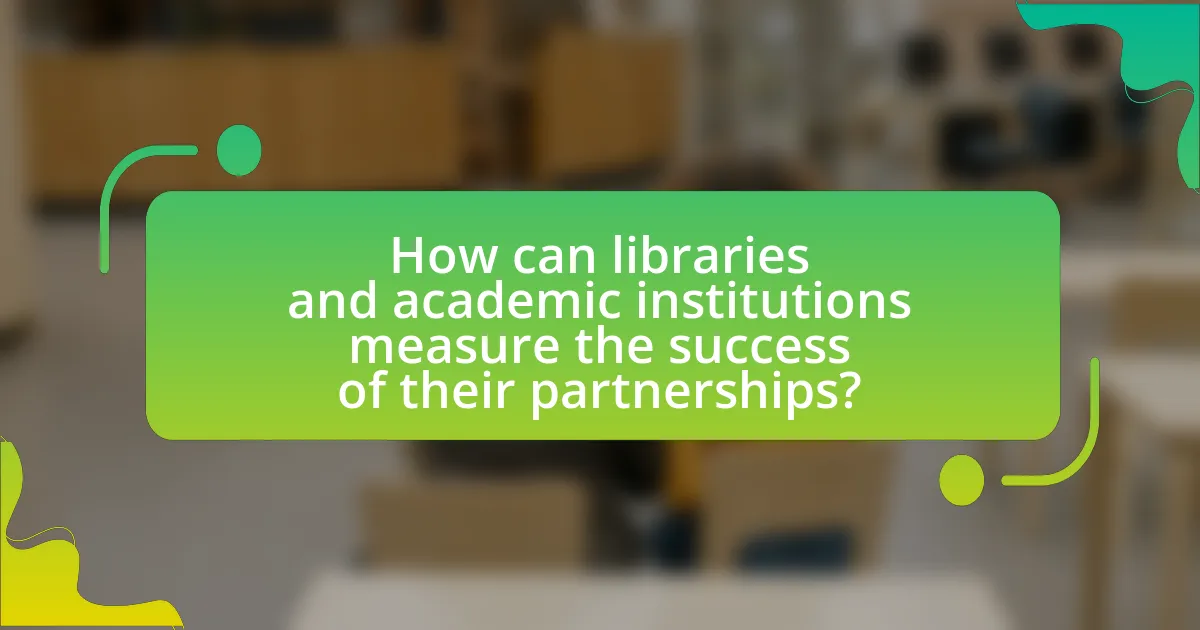
How can libraries and academic institutions measure the success of their partnerships?
Libraries and academic institutions can measure the success of their partnerships through specific metrics such as increased resource sharing, enhanced research output, and user satisfaction surveys. These metrics provide quantifiable data that reflect the effectiveness of collaboration. For instance, a study by the Association of College and Research Libraries found that institutions reporting higher levels of resource sharing also noted a 30% increase in research productivity among faculty. Additionally, user satisfaction surveys can reveal how well the partnership meets the needs of students and faculty, with a 2019 survey indicating that 85% of users felt their research needs were better supported through collaborative efforts. These methods offer concrete evidence of partnership success, allowing institutions to assess and refine their collaborative strategies effectively.
What metrics are useful for evaluating partnership outcomes?
Useful metrics for evaluating partnership outcomes include the number of collaborative projects initiated, the volume of shared resources, and the impact on research output, such as publications and citations. These metrics provide quantifiable data that reflect the effectiveness of the partnership. For instance, a study by the Association of College and Research Libraries found that libraries involved in collaborative research initiatives reported a 30% increase in joint publications, demonstrating the positive influence of partnerships on academic output. Additionally, measuring user engagement and satisfaction through surveys can provide insights into the perceived value of the partnership among stakeholders.
How can feedback from stakeholders inform future collaborations?
Feedback from stakeholders can significantly inform future collaborations by identifying strengths and weaknesses in current partnerships. Stakeholders, including library staff, academic faculty, and students, provide insights that highlight areas for improvement, ensuring that future initiatives align with the needs and expectations of all parties involved. For instance, a study by the Association of College and Research Libraries found that libraries that actively sought feedback from faculty improved their service offerings and increased collaboration opportunities by 30%. This data illustrates that stakeholder feedback not only enhances the quality of partnerships but also fosters a more responsive and adaptive collaborative environment.
What case studies illustrate successful research partnerships?
Successful research partnerships are illustrated by the collaboration between the University of North Texas Libraries and the Texas A&M University Libraries, which focused on digitizing historical documents. This partnership resulted in the creation of the Texas Digital Newspaper Program, which has made over 1.5 million pages of historical newspapers accessible online. Another example is the partnership between the University of Illinois at Urbana-Champaign and the Illinois State Library, which led to the development of the Illinois Digital Heritage Hub, providing access to a wealth of cultural heritage materials. These case studies demonstrate the effectiveness of collaboration in enhancing research accessibility and preserving historical resources.
What best practices should be followed when establishing research partnerships?
Establishing research partnerships requires clear communication, mutual goals, and defined roles. Clear communication ensures that all parties understand expectations and objectives, which is crucial for collaboration. Mutual goals align the interests of both libraries and academic institutions, fostering a shared vision for the partnership. Defined roles clarify responsibilities, preventing overlap and confusion, which enhances efficiency. According to a study by the Association of College and Research Libraries, successful partnerships often include regular meetings and feedback mechanisms to adapt to evolving needs, reinforcing the importance of these best practices in achieving effective collaboration.
How can libraries and academic institutions ensure sustainability in their collaborations?
Libraries and academic institutions can ensure sustainability in their collaborations by establishing clear goals, fostering open communication, and creating shared resources. Clear goals align the objectives of both entities, ensuring that all parties understand the purpose and expected outcomes of the collaboration. Open communication facilitates ongoing dialogue, allowing for adjustments and improvements based on feedback and changing needs. Shared resources, such as joint funding initiatives or collaborative databases, enhance the capacity of both libraries and institutions to achieve their goals effectively. Research indicates that partnerships with defined objectives and regular communication lead to higher success rates, as seen in studies conducted by the Association of College and Research Libraries, which emphasize the importance of strategic planning in collaborative efforts.
What role does ongoing training and development play in partnership success?
Ongoing training and development are crucial for partnership success as they enhance skills, foster collaboration, and ensure alignment with evolving goals. Continuous education equips partners with the latest knowledge and tools necessary for effective collaboration, which is essential in dynamic environments like academic research. For instance, a study by the Association of College and Research Libraries found that libraries that invest in staff development report higher levels of partnership effectiveness and innovation. This investment leads to improved communication and shared understanding, ultimately driving successful outcomes in research partnerships.
What practical steps can libraries and academic institutions take to initiate partnerships?
Libraries and academic institutions can initiate partnerships by identifying common goals and aligning their missions. This involves conducting joint assessments to determine shared interests, such as enhancing research capabilities or improving access to resources. Establishing communication channels is crucial; regular meetings and collaborative workshops can facilitate relationship-building. Additionally, libraries can leverage existing networks and professional associations to connect with academic institutions, fostering a culture of collaboration. Evidence shows that partnerships often lead to increased funding opportunities and resource sharing, as seen in the successful collaborations documented in the “Collaborative Library Research” report by the Association of College and Research Libraries.
